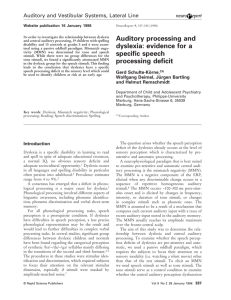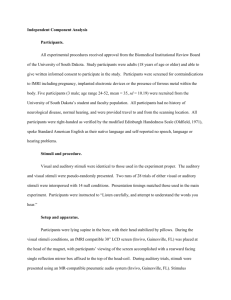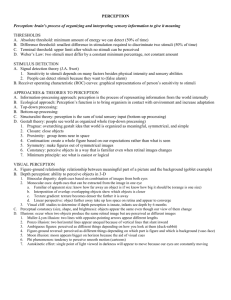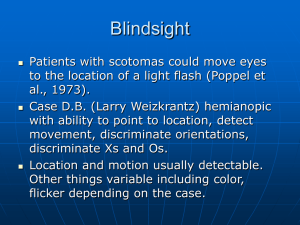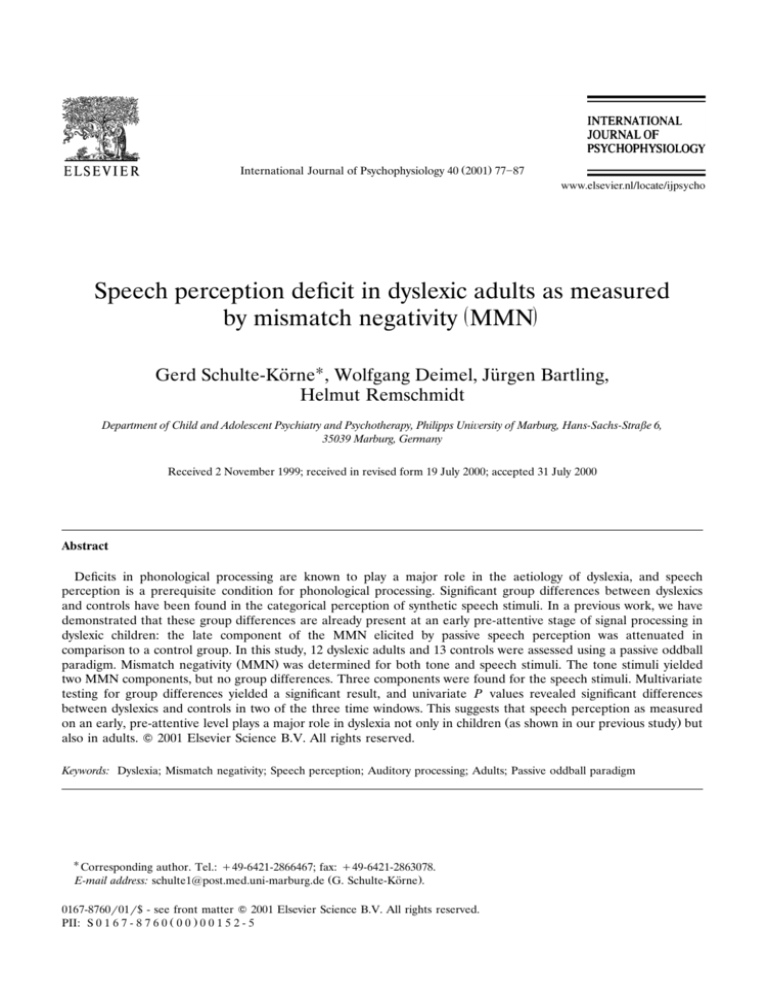
International Journal of Psychophysiology 40 Ž2001. 77᎐87
Speech perception deficit in dyslexic adults as measured
by mismatch negativity ž MMN/
Gerd Schulte-Korne
Bartling,
¨ U , Wolfgang Deimel, Jurgen
¨
Helmut Remschmidt
Department of Child and Adolescent Psychiatry and Psychotherapy, Philipps Uni¨ ersity of Marburg, Hans-Sachs-Straße 6,
35039 Marburg, Germany
Received 2 November 1999; received in revised form 19 July 2000; accepted 31 July 2000
Abstract
Deficits in phonological processing are known to play a major role in the aetiology of dyslexia, and speech
perception is a prerequisite condition for phonological processing. Significant group differences between dyslexics
and controls have been found in the categorical perception of synthetic speech stimuli. In a previous work, we have
demonstrated that these group differences are already present at an early pre-attentive stage of signal processing in
dyslexic children: the late component of the MMN elicited by passive speech perception was attenuated in
comparison to a control group. In this study, 12 dyslexic adults and 13 controls were assessed using a passive oddball
paradigm. Mismatch negativity ŽMMN. was determined for both tone and speech stimuli. The tone stimuli yielded
two MMN components, but no group differences. Three components were found for the speech stimuli. Multivariate
testing for group differences yielded a significant result, and univariate P values revealed significant differences
between dyslexics and controls in two of the three time windows. This suggests that speech perception as measured
on an early, pre-attentive level plays a major role in dyslexia not only in children Žas shown in our previous study. but
also in adults. 䊚 2001 Elsevier Science B.V. All rights reserved.
Keywords: Dyslexia; Mismatch negativity; Speech perception; Auditory processing; Adults; Passive oddball paradigm
U
Corresponding author. Tel.: q49-6421-2866467; fax: q49-6421-2863078.
E-mail address: schulte1@post.med.uni-marburg.de ŽG. Schulte-Korne
¨ ..
0167-8760r01r$ - see front matter 䊚 2001 Elsevier Science B.V. All rights reserved.
PII: S 0 1 6 7 - 8 7 6 0 Ž 0 0 . 0 0 1 5 2 - 5
78
G. Schulte-Korne
¨ et al. r International Journal of Psychophysiology 40 (2001) 77᎐87
1. Introduction
Dyslexia is a specific disability in reading and
spelling despite adequate educational resources, a
normal IQ, no obvious sensory deficits, and adequate sociocultural opportunity ŽDilling et al.,
1991.. Dyslexia occurs in all languages, and
spelling disability in particular often persists into
adulthood. Prevalence estimates range from 4 to
9% ŽShaywitz et al., 1990..
Deficits in phonological processing are known
to play a major role in the aetiology of dyslexia
ŽElbro, 1996., and speech perception was found
to be a prerequisite condition for phonological
processing ŽWatson and Miller, 1993; McBrideChang, 1995; Schulte-Korne
et al., 1999b.. In
¨
several studies, significant group differences have
been found between dyslexic children and normals regarding the categorical perception of synthetic rbar᎐rdar᎐rgar syllables ŽGodfrey et
al., 1981; Manis et al., 1997; Werker and Tees,
1987.. These studies used stimulus identification
and discrimination tasks, which required the subjects to focus on the relevant stimulus dimension.
These cognitive processes could have been influenced by attention, motivation, and memory-span
performance, all of which have been demonstrated to be abnormal in dyslexia ŽJorm, 1983;
Schulte-Korne
et al., 1991.. Thus it remains un¨
clear whether the deficits in speech perception
demonstrated represent an underlying deficit in
dyslexia, reflect a secondary effect, or are caused
along with dyslexia by the same underlying, as yet
unknown, deficit. Therefore, the question arises
as to whether the speech perception deficit described in dyslexics occurs on the level of sensory
perception which is characterised by pre-attentive
and automatic processing.
A neurophysiological paradigm well-suited to
examine pre-attentive and automatic central auditory processing is the mismatch negativity
ŽMMN.. This is a negative component of the
event-related brain potential ŽERP., elicited when
a detectable change occurs in repetitive homogeneous auditory stimuli ŽNaatanen,
1992.. The most
¨¨ ¨
commonly described MMN occurs at 100᎐300 ms
post-stimulus onset although other studies have
found later MMNs between 300 and 600 ms
ŽKraus et al., 1996.. The MMN is elicited by any
change in frequency, intensity or duration of tone
stimuli, as well as by changes in complex stimuli
such as phonetic stimuli ŽNaatanen,
1992.. It is
¨¨ ¨
assumed to arise as a result of a mechanism that
compares each current auditory input with a trace
of recent auditory input stored in the auditory
memory. The MMN usually reaches its amplitude
maximum over the fronto-central scalp ŽNaatanen,
¨¨ ¨
1992..
In a study with dyslexic children we have already demonstrated that the late component of
the MMN elicited by passive speech perception
was attenuated in comparison to a control group
ŽSchulte-Korne
¨ et al., 1998.. This attenuation was
detected only with speech but not with tone stimuli, supporting the hypothesis that dyslexics have
a specific speech processing deficit at a sensory
level. Further evidence for a specific speech processing deficit in dyslexic children and adults came
from the studies of Watson and Miller Ž1993. and
Schulte-Korne
et al. Ž1999b.. They found no in¨
fluence of the ability to discriminate tone stimuli
or detect a gap between bursts on reading and
spelling ability.
It is well described that dyslexic children often
continue to have difficulties into adulthood, especially in spelling ŽDilling et al., 1991., however,
the role of speech perception in dyslexia in adults
has not yet been extensively examined. Dyslexics
have been shown to have difficulties in speech
identification and discrimination tasks ŽLiberman
et al., 1985; Steffens et al., 1992; Cornelissen et
al., 1996., but tasks in all of these three studies
required subjects to focus on the stimuli, thus the
results may have been influenced by factors such
as motivation and attention. In the current study
we used a passive oddball paradigm which requires the subjects to focus on a sensory modality
other than that of the test stimuli. We have
examined a sample of spelling disabled adults to
clarify whether the previously described deficits in
speech perception in children can also be found
in adults. To elicit an MMN we used synthetic
speech as well as tone stimuli. The latter served
as a control condition to examine whether the
auditory processing deficit is specific for speech
G. Schulte-Korne
¨ et al. r International Journal of Psychophysiology 40 (2001) 77᎐87
79
Table 1
Sample characteristics of dyslexics and controls
Controls
Dyslexics
n
M:F
Age
IQ
Spelling percentage rank
13
12
4:9
8:4
29.0" 5.9
30.5" 8.6
119.7" 14.6
110.3" 14.6
78.2" 21.3
11.1" 9.7
stimuli. It was hypothesised that as with children,
adult dyslexics would have an attenuated MMN
in the speech but not in the tone condition.
2. Methods
Twelve dyslexic adults were recruited through
an adult education centre and an announcement
in the Dyslexia Association Journal. The history
revealed that all had had difficulties as children in
reading and spelling, and a reading test ŽSchulteKorne,
2000. revealed a significant difference in
¨
reading speed between them and the controls.
Spelling was measured by an age-appropriate
German spelling test ŽJager
¨ and Jundt, 1981. and
spelling disability was diagnosed if there was a
discrepancy of at least 1 S.D. between actual
spelling ability and that predicted on the basis of
IQ Žlinear regression model, Schulte-Korne
¨ et al.,
1996.. The 13 controls were recruited through
advertisements in the local press, notices in the
Psychology Department of the Philipps University
of Marburg, and personal contacts. Exclusion
criteria were: an uncorrected visual deficit, a
hearing deficit, relevant psychiatric or emotional
disorder, a history of fits, other neurological disorders, or a bilingual family. All subjects reported
themselves to be strongly right-handed, had a
good school attendance record and an IQ Žmeasured by German adaptation of the Culture Fair
Intelligence Test, CFT20; Weiß, 1987. greater
than 85. For sample characteristics see Table 1.
Tone stimuli were produced by 2200 Hz Žstandard. and 2640 Hz Ždeviant. sine waves of 90 ms
duration with 3 ms rise and 3 ms fall time. Synthesised speech stimuli were created by a Klatt
synthesiser ŽKlatt, 1980., the standard stimulus
was da and the deviant was ga. Each speech
stimulus was of 110 ms duration. Stimuli were
presented in two blocks: speech and tone. In each
block, 1800 standard stimuli and 200 deviant stimuli were presented in a pseudorandom order
with at least five standards between any two deviants and a constant onset to onset interval of
590 ms between stimuli. The stimuli were presented binaurally by insert earphones. The sound
level was set to 70 dB SPL. Calibrations were
performed with a Bruel and Kjaer 2235 sound
level meter and an artificial ear ŽBruel and Kjaer,
model 4152. with a 6-cm3 coupler to approximate
the volume of the external ear. Subjects were
seated in a comfortable chair in a quiet room.
They were specifically instructed not to attend to
the presented stimuli, and to aid them in this, a
self-selected film was shown.
Electrodes were placed at 19 scalp sites based
on the International 10᎐20 system: Fp1, Fp2, F7,
F8, F3, F4, Fz, C3, C4, Cz, T3, T4, T5, T6, P3, P4,
Pz, O1, and O2 with reference to the linked ears.
The ground electrode was positioned at Fpz. Horizontal and vertical eye movements and blinks
were detected with two additional electrodes
placed below the subjects’ right and left eyes and
the Fp1 and Fp2 electrodes. Electrode impedances
were kept below 10 k ⍀. The EEG was amplified
by Schwarzer amplifiers, with time constant set to
0.6 s and using a low pass filter with half amplitude at 85 Hz. The EEG was recorded continuously and ArD converted with 12-bit resolution
at a sampling rate of 172 Hz.
Artefact detection was facilitated by the use of
a computer program developed at our Institute.
EEG epochs in which either the EEG exceeded
"70 V or the electro-ocular ŽEOG. activity
exceeded "30 V relative to the baseline were
automatically excluded from averaging, leaving a
minimum of 68 deviant and 580 standard trials
for averaging. This procedure was checked visually to verify its accuracy. ERPs were calculated
80
G. Schulte-Korne
¨ et al. r International Journal of Psychophysiology 40 (2001) 77᎐87
by averaging epochs of 750 ms Žincluding a 50-ms
prestimulus interval. separately for both standard
and deviant stimuli. The first two standard EEG
epochs following each deviant epoch were omitted from averaging because they were assumed to
represent a mismatch process related to the preceding deviant. Data from T3 and T4 had to be
excluded from further analyses because of an
accumulation of muscle artefacts. Difference
waveforms ŽMMN curves. were calculated by subtracting the averaged standard from the averaged
deviant ERP. Peak amplitudes and latencies were
calculated for each subject searching the maximum peak in the respective intervals ŽFigs. 1 and
2. gained from visual grand average inspection.
Since the assumed maximum of activity was over
Fz ŽNaatanen,
1992., data from this electrode
¨¨ ¨
were used for statistical calculations.
the two MMN components. According to visual
inspection of the data, there is no evidence for
latency differences between the groups.
A MANOVA was performed to examine the
effect of group Ždyslexics vs. controls. on the peak
amplitudes. No significant differences were found.
In order to compare the spatial distribution of the
MMN activity between the two groups Ždyslexia
vs. controls., brain maps were calculated to show
the mean amplitudes for the two time windows
ŽMMN 1 and 2, Fig. 2..
There is no suggestion of a different lateralisation between the groups. There seem to be group
differences at some of the electrodes regarding
the average activation, but over the expected
frontal leads group differences were not significant ŽTable 2..
3.2. Analysis of speech stimuli
3. Results
3.1. Analysis of tone stimuli
Fig. 1 shows 2 MMN peaks ŽFz., an early one
Ž70᎐230 ms. and a late one Ž370᎐590 ms.. Table 2
shows the peak amplitudes and the latencies of
Compared with the tone stimuli, the speech
stimuli did not produce a comparable, clearly
differentiated MMN. A number of different MMN
components were produced, all of comparably low
amplitude. In order to check which parts of the
curve contain meaningful negativity rather than
mere background noise, all values of the control
Fig. 1. Grand average of the mismatch negativity ŽMMN. for tone stimuli in dyslexic subjects Žbroken line. and controls Žsolid line.
at Fz Žfronto-central lead.. The responses to the standard stimulus have been subtracted from those to the deviant stimulus.
G. Schulte-Korne
¨ et al. r International Journal of Psychophysiology 40 (2001) 77᎐87
81
Fig. 2. Scalp distribution of the tone MMN in the two time windows. The grey steps indicate the amount of activation. The
corresponding range Žin V. was set individually for each pair of scalp distributions.
group were tested against zero using t-tests. Values1 in three areas proved to be significantly
different from zero, and therefore the peak amplitudes from these three time windows were used
for the purpose of further analyses ŽFig. 3.. In the
group of dyslexics, however, only in window 1 an
MMN could be found.
The time windows between MMN1 and MMN2,
and between 100 and 220 ms also contained peak
values comparable to those in the MMN windows
1
Each value Ždata point. of the curve is the average of all
subjects’ amplitude values of that particular time and in the
respective group. Visual inspection of the curve of the control
group yielded four possible analysis windows with distinguishable peaks. t-tests in 3 of the 4 possible windows resulted in a
considerable number of significant values.
1᎐3. These parts of the graph were, however, not
significant because the underlying variances were
too large. According to visual inspection of the
data, there is no evidence for latency differences
between the groups. A further illustration of the
data is provided by Figs. 4 and 5, which show not
only the MMN graphs, but also the underlying
curves of the standard and deviant stimuli.
Table 2
Means and standard deviations of the MMN peak amplitudes
and latencies for tone stimuli
MMN1, amplitude
MMN2, amplitude
MMN1, latency
MMN2, latency
Controls
Dyslexics
y3.88" 1.78 V
y3.22" 1.90 V
124.15" 28.51 ms
457.70" 54.22 ms
y3.29" 1.19 V
y2.31" 1.90 V
135.83" 46.55 ms
493.92" 52.16 ms
82
G. Schulte-Korne
¨ et al. r International Journal of Psychophysiology 40 (2001) 77᎐87
Fig. 3. Grand average of the MMN for speech stimuli in dyslexic subjects Žbroken line. and controls Žsolid line. at Fz. The
responses to the standard stimulus have been subtracted from those to the deviant stimulus. The black bars indicate ranges of the
curve with significant MMN values in the control group.
Fig. 4. Grand average of the standard stimuli Ždotted line., the deviant stimuli Žsolid line., and the mismatch negativity ŽMMN, bold
line. for speech stimuli in control subjects at Fz Žfronto-central lead..
G. Schulte-Korne
¨ et al. r International Journal of Psychophysiology 40 (2001) 77᎐87
83
Fig. 5. Grand average of the standard stimuli Ždotted line., the deviant stimuli Žsolid line. and the mismatch negativity ŽMMN, bold
line. for speech stimuli in dyslexic subjects at Fz Žfronto-central lead..
A MANOVA was also undertaken for the peaks
of the three speech MMNs Žmain effect group,
three dependent variables.. The multivariate F
value was significant Ž Ps 0.039.. Because of this
borderline result, the univariate P values were
also examined. These were Ps 0.24 Žpeak 1.,
Ps 0.03 Žpeak 2. and Ps 0.005 Žpeak 3.. Whilst
caution must be exercised in interpreting these
a-posteriori-analyses, it could be argued that the
group differences are only present in the latter
two time windows ŽTable 3..
In order to compare the spatial distribution of
the MMN activity between the two groups Ždyslexia vs. controls., brain maps were calculated to
Table 3
Means and standard deviations of the MMN peak amplitudes
and latencies for speech stimuli
MMN1, amplitude
MMN2, amplitude
MMN3, amplitude
MMN1, latency
MMN2, latency
MMN3, latency
Controls
Dyslexics
y2.51" 2.19 V
y2.53" 2.21 V
y2.53" 1.59 V
291.23" 26.89 ms
511.31" 21.25 ms
597.54" 24.01 ms
y1.63" 1.27 V
y1.00" 0.70 V
y0.87" 0.99 V
301.92" 27.39 ms
498.67" 30.84 ms
590.25" 28.53 ms
show the mean amplitudes for the three time
windows ŽMMN 1, 2, and 3; Fig. 6..
Fig. 6 demonstrates higher MMN activation in
the control group over all three time windows.
The maximal activation occurs over the right
frontal region ŽF4.. The lateralisation increases as
the latency of the components increases. There is
no suggestion of a different lateralisation between
the groups.
4. Discussion
We have tried to find evidence supporting the
hypothesis of a specific speech perception deficit
in dyslexia by looking for a reduced MMN amplitude following the presentation of speech stimuli.
The group comparison yielded a significantly
reduced MMN on speech stimuli in the dyslexic
group. This difference appears to be speech
specific 2 since it was not detected with the tone
2
However, it is unclear which attribute of the speech stimuli, e.g. the rapid transition of formants, leads to the group
differences.
84
G. Schulte-Korne
¨ et al. r International Journal of Psychophysiology 40 (2001) 77᎐87
Fig. 6. Scalp distribution of the speech MMN in the three time windows. The grey steps indicate the amount of activation. The
corresponding range Žin V. was set individually for each pair of scalp distributions.
stimuli. It can be concluded that dyslexic adults
have a specific weakness in the passive perception
of speech, as already shown in dyslexic children
ŽSchulte-Korne
et al., 1998.. Another study sup¨
porting this result was conducted by Uwer et al.
Ž2000.. The authors found a reduced MMN in
dyslexic children with speech, but not with tone
stimuli.
However, Baldeweg et al. Ž1999. found a reduced area of the frequency MMN in dyslexics
with tone stimuli. Although a total of three studies now favors a speech specific deficit in dyslex-
G. Schulte-Korne
¨ et al. r International Journal of Psychophysiology 40 (2001) 77᎐87
ics, with the deviating result of Baldeweg et al.
Ž1999. this issue remains controversial.
An interesting finding was that the MMN appears to have more than one component, both for
tone as well as speech stimuli. Only in the later
components of the speech MMN were significant
group differences detected. This finding concurs
with the results of our previous work where
dyslexic children and adults were found to have a
significantly attenuated MMN elicited by speech
and complex tone patterns between 300 and 600
ms ŽSchulte-Korne
et al., 1998, 1999a.. Several
¨
other groups have also found MMN activity later
than 300 ms ŽSams et al., 1990; Sandridge and
Boothroyd, 1996; Sharma et al., 1993.. In some
other studies the interstimulus interval was so
short that it would not have been possible to
detect the presence of any later MMN component ŽAlain et al., 1998.; whilst in others, the
traces were discontinued after 300 ms ŽNyman et
al., 1990; Naatanen
et al., 1997., such that the
¨¨ ¨
analysis of the later components was no longer
possible. The works of Tremblay et al. Ž1997. and
Winkler et al. Ž1999. have clearly documented the
presence of MMN components in the time window from 300 to 500 ms in response to presentation of consonant vowel clusters. We feel it is
important to further investigate the significance
of these components, and in particular to clarify
whether this represents an additional mismatch
process that is tied to a speech specific deficit in
dyslexics.
Fz was used to calculate the group differences;
the brain maps show that there is lateralisation to
the right hemisphere. Since this is true for both
groups, it can be assumed that testing over F4
would result in the same group differences than
over Fz. Testing over F4 was not carried out
because a-posteriori testing is not recommendable for statistical reasons Žthe resulting p values
would no longer be appropriate.. The finding that
the late component of the speech MMN is lateralised to the right frontal hemisphere might correspond to results of Kasai et al. Ž1999. who
found that there are several generators of MMN
in the temporal and frontal lobes of both hemispheres. Giard et al. Ž1990. found an MMN com-
85
ponent over the right frontal area which might be
related to an automatic attention switch process.
In comparison to the more central speech MMN
found in our study with dyslexic children, the late
component of the speech MMN in adults has
been lateralised to the right.
The processing deficit of the stop consonant
speech stimuli which are characterised by brief
and rapid spectral changes might correspond to
the finding of Tallal Ž1980. that dyslexics are
impaired when processing brief, rapidly changing
auditory stimuli. We have recently found evidence for this hypothesis ŽSchulte-Korne
et al.,
¨
1999a.. Dyslexic adults were found to have a
significant pre-attentive deficit in processing of
rapid temporal patterns suggesting that it may be
the temporal information embedded in speech
sounds, rather than phonetic information per se,
that resulted in the attenuated MMN found in
dyslexics in previous studies.
The most likely interpretation of our data is
that the attenuated MMN in dyslexics is speech
specific. The works of Mody et al. Ž1997. and
Adlard and Hazan Ž1998. also support the theory
that dyslexics have a specific speech perception
deficit. In these studies, however, active speech
perception was investigated. The results of this
study and the study with dyslexic children
ŽSchulte-Korne
et al., 1998. provide strong evi¨
dence that the speech discrimination difficulties
of dyslexics occur already before conscious perception. The finding that speech perception is
developed in early years of childhood ŽKuhl et al.,
1992. suggests that deficits in pre-attentive speech
processing are a basic dysfunction in dyslexics
which continues to have an important impact in
dyslexia into adulthood.
Acknowledgements
The work reported here was supported by
grants ŽSchu988r2-3,2-4. from the Deutsche
Forschungsgemeinschaft. We thank G. Curio
ŽBerlin. for careful reading of an earlier version
of the manuscript.
86
G. Schulte-Korne
¨ et al. r International Journal of Psychophysiology 40 (2001) 77᎐87
References
Adlard, A., Hazan, V., 1998. Speech perception in children
with specific reading difficulties Ždyslexia.. Q. J. Exp. Psychol. A. 51, 153᎐177.
Alain, A., Woods, D.L., Knight, R.T., 1998. A distributed
cortical network for auditory sensory memory in humans.
Brain Res. 812, 23᎐37.
Baldeweg, T., Richardson, A., Watkins, S., Foale, C., Gruzelier, J., 1999. Impaired auditory frequency discrimination in
dyslexia detected with mismatch evoked potentials. Ann.
Neurol. 45, 495᎐503.
Cornelissen, P.L., Hansen, P.C., Bradley, L., Stein, J.F., 1996.
Analysis for perceptual confusions between nine sets of
consonant᎐vowel sounds in normal and dyslexic adults.
Cognition 59, 275᎐306.
Dilling, H., Mombour, W., Schmidt, M.H., 1991. International
Classification of Mental Diseases, ICD-10, German edition
Huber, Bern.
Elbro, C., 1996. Early linguistic abilities and reading development: a review and a hypothesis. Read. Writ. 8, 453᎐485.
Giard, M.H., Perrin, F., Pernier, J., Bouchet, P., 1990. Brain
generators implicated in the processing of auditory stimulus deviance: a topographic event-related potential study.
Psychophysiology 27, 627᎐640.
Godfrey, J.J., Syrdal-Laskey, A.K., Millay, K.K., Knox, C.M.,
1981. Performance of dyslexic children on speech perception tests. J. Exp. Child Psychol. 32, 401᎐424.
Jager,
R.S., Jundt, E., 1981. Mannheimer Rechtschreib-Test
¨
ŽM-R-T., Hogrefe, Gottingen.
¨
Jorm, A.F., 1983. Specific reading retardation and working
memory: a review. Br. J. Psychol. 74, 311᎐342.
Kasai, K., Nakagome, K., Itoh, K. et al., 1999. Multiple generators in the auditory automatic discrimination process in
humans. Neuroreport 10, 2267᎐2271.
Klatt, D.H., 1980. Speech perception. A model of acousticphonemic analysis and lexical access. J, Phon. 8, 279᎐312.
Kraus, N., McGee, T., Carell, T., Zecker, S., Nicol, T., Koch,
D., 1996. Auditory neuro physiologic response and discrimination deficits in children with learning problems. Science
273, 971᎐973.
Kuhl, P.K., Williams, K.A., Lacerda, F., 1992. Linguistic experience alters phonetic perception in infants by 6 months of
age. Science 255, 606᎐608.
Liberman, P., Meskill, R.H., Chatillon, M., Schupack, H.,
1985. Phonetic speech perception deficits in dyslexia. J.
Speech Hear. Res. 28, 480᎐487.
Manis, F.R., McBride-Chang, C, Seidenberg, M.S. et al., 1997.
Are speech perception deficits associated with developmental dyslexia? J. Exp. Child Psychol. 66, 211᎐235.
McBride-Chang, C., 1995. Phonological processing, speech
perception, and reading disability: an integrative review.
Educ. Psychol. 30, 109᎐121.
Mody, M., Studdert-Kennedy, M., Brady, S., 1997. Speech
perception deficits in poor readers: auditory processing or
phonological coding? J Exp. Child Psychol. 64, 199᎐231.
Naatanen,
R., 1992. Attention and Brain Function. Lawrence
¨¨ ¨
Erlbaurn, Hillsdale.
Naatanen,
R., Lehtokoski, A., Lennes, M. et al., 1997. Lan¨¨ ¨
guage-specific phoneme representations revealed by electric and magnetic brain responses. Nature 385, 432᎐434.
Nyman, G., Alho, K., Laurinen, P. et al., 1990. Mismatch
negativity ŽMMN. for sequences of auditory and visual
stimuli: evidence for a mechanism specific to the auditory
modality. Electroencephalogr. Clin. Neurophysiol 77,
436᎐444.
Sams, M., Aulanko, R., Aaltonen, O., Naatanen,
R., 1990.
¨¨ ¨
Event-related potentials to infrequent changes in synthesized phonetic stimuli. J. Cogn. Neuro. 2, 344᎐357.
Sandridge, S.A., Boothroyd, A., 1996. Using naturally produced speech to elicit the mismatch negativity. J Am. Acad.
Audiol. 7, 105᎐112.
Schulte-Korne,
G. Ž2000. Lese-Rechtschreibschwache
und
¨
¨
Žin print..
Sprachwahrnehmung, Waxmann, Munster
¨
Schulte-Korne,
G., Deimel, W., Bartling, J., Remschmidt, H.,
¨
1998. Auditory processing and dyslexia: evidence for a
specific speech processing deficit. Neuroreport 9, 337᎐340.
Schulte-Korne,
G., Deimel, W., Bartling, L., Remschmidt, H.,
¨
1999a. Pre-attentive processing of auditory patterns in
dyslexic human subjects. Neurosci Lett. 276, 41᎐44.
Schulte-Korne,
G., Deimel, W., Bartling, J., Remschmidt, H.,
¨
1999b. The role of phonological awareness, speech perception, and auditory temporal processing for dyslexia. Eur.
Child Adolesc. Psychiat Suppl. 3, 28᎐34.
Schulte-Korne,
G., Deimel, W., Muller,
K., Gutenbrunner, C.,
¨
¨
Remschmidt, H., 1996. Familial aggregation of spelling
disability. J. Child Psychol. Psychiat. 37, 817᎐822.
Schulte-Korne,
G., Remschmidt, H., Warnke, A., 1991. Selec¨
tive visual attention and continuous attention in dyslexic
children. An experimental study. Z. Kinder Jugendpsychiatr 19, 99᎐106.
Sharma, A., Kraus, N., McGee, T., Carrell, T., Nicol, T., 1993.
Acoustic versus phonetic representation of speech as reflected by the mismatch negativity event-related potential.
Electroencephalogr. Clin. Neurophysiol. 88, 64᎐71.
Shaywitz, S.E., Shaywitz, B.A., Fletcher, J.M., Escobar, M.D.,
1990. Prevalence of reading disability in boys and girls. J.
Am. Med. Assoc. 264, 998᎐1002.
Steffens, M.L., Eilers, R.E., Gross-Glenn, K., Jallad, B., 1992.
Speech perception in adult subjects with familial dyslexia. J.
Speech Hear. Res. 35, 192᎐200.
Tallal, P., 1980. Auditory temporal perception, phonics, and
reading disabilities in children. Brain Lang. 9, 182᎐198.
Tremblay, K., Kraus, N., Carrell, T.D., McGee, T., 1997.
Central auditory system plasticity: generalization to novel
stimuli following listening training. J. Acoust. Soc. Am. 102,
3762᎐3773.
Uwer, R., Albrecht, W., v. Suchodoletz, W. Ž2000. Die Mismatch Negativity auf Sprach- und Tonstimuli bei Kindern
mit Lese-Rechtschreibschwache.
Paper presented at the
¨
Meeting of the German Association of Child and Adolescent Psychiatry, Jena.
G. Schulte-Korne
¨ et al. r International Journal of Psychophysiology 40 (2001) 77᎐87
Watson, B.U., Miller, T.K., 1993. Auditory perception, phonological processing, and reading abilityrdisability. J Speech
Hear. Res. 36, 850᎐863.
Weiß, R.H., 1987. Grundintelligenztest Skala 2 CFT 20, 3rd
edition Westermann, Braunschweig.
Werker, J.F., Tees, R.C., 1987. Speech perception in severely
87
disabled and average reading children. Canadian J. Psychol.
41, 48᎐61.
Winkler, I., Lehtokoski, A., Alku, P. et al., 1999. Pre-attentive
detection of vowel contrasts utilises both phonemic and
auditory memory representations. Brain Res. 7, 357᎐369.


